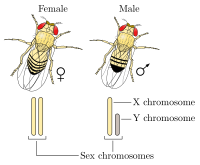
Back نظام تحديد الجنس XY Arabic এক্সওয়াই লিঙ্গ-নির্ধারণ ব্যবস্থা Bengali/Bangla XY sistem određivanja spola BS Sistema XY de determinación del sexo Spanish روش گزینش جنسی XY Persian Système XY de détermination sexuelle French Sistema de determinación do sexo XY Galician Ivart meghatározó XY rendszer Hungarian Sistem penentuan kelamin XY ID Sîstema XY ya diyarbûna zayendê Kurdish
| Part of a series on |
| Sex |
|---|
 |
| Biological terms |
| Sexual reproduction |
| Sexuality |
| Sexual system |

The XY sex-determination system is a sex-determination system used to classify many mammals, including humans, some insects (Drosophila), some snakes, some fish (guppies), and some plants (Ginkgo tree). In this system, the sex of an individual is determined by a pair of sex chromosomes. Females have two of the same kind of sex chromosome (XX), and are called the homogametic sex. Males have two different kinds of sex chromosomes (XY), and are called the heterogametic sex.[1]
In humans, the presence of the Y chromosome is responsible for triggering male development; in the absence of the Y chromosome, the fetus will undergo female development. There are various exceptions, such as individuals with Klinefelter syndrome (who have XXY chromosomes), Swyer syndrome (women with XY chromosomes), and XX male syndrome (de la Chapelle syndrome, men with XX chromosomes), however these exceptions are rare. In some instances, a seemingly normal female with a vagina, cervix, and ovaries has XY chromosomes, but the SRY gene has been shut down.[2] In most species with XY sex determination, an organism must have at least one X chromosome in order to survive.[3][4]
The XY system contrasts in several ways with the ZW sex-determination system found in birds, some insects, many reptiles, and various other animals, in which the heterogametic sex is female. It had been thought for several decades that in all snakes sex was determined by the ZW system, but there had been observations of unexpected effects in the genetics of species in the families Boidae and Pythonidae; for example, parthenogenic reproduction produced only females rather than males, which is the opposite of what is to be expected in the ZW system. In the early years of the 21st century such observations prompted research that demonstrated that all pythons and boas so far investigated definitely have the XY system of sex determination.[5][6]
A temperature-dependent sex determination system is found in some reptiles and fish.
- ^ Hake, Laura; O'Connor, Clare (2008). "Genetic Mechanisms of Sex Determination | Learn Science at Scitable". Nature. Archived from the original on 2021-04-28. Retrieved 2021-04-13.
- ^ Callaway, Ewen (9 April 2009). "Girl with Y chromosome sheds light on maleness". New Scientist. Retrieved 2023-02-22.
- ^ Sherwood, Susan. "Can a Zygote Survive Without an X Sex Chromosome?". Education - Seattle PI. Retrieved 2020-11-08.
- ^ Sherwood, Susan (April 25, 2017). "What Occurs When the Zygote Has One Fewer Chromosome than Usual?". Sciencing. Retrieved 2021-04-29.
- ^ Gamble, Tony; Castoe, Todd A.; Nielsen, Stuart V.; Banks, Jaison L.; Card, Daren C.; Schield, Drew R.; Schuett, Gordon W.; Booth, Warren (2017). "The Discovery of XY Sex Chromosomes in a Boa and Python" (PDF). Current Biology. 27 (14): 2148–2153.e4. Bibcode:2017CBio...27E2148G. doi:10.1016/j.cub.2017.06.010. PMID 28690112. Archived (PDF) from the original on Nov 26, 2023 – via e-Publications@Marquettee.
- ^ Olena, Abby (July 6, 2017). "Snake Sex Determination Dogma Overturned". The Scientist. Archived from the original on Dec 8, 2023.
© MMXXIII Rich X Search. We shall prevail. All rights reserved. Rich X Search

